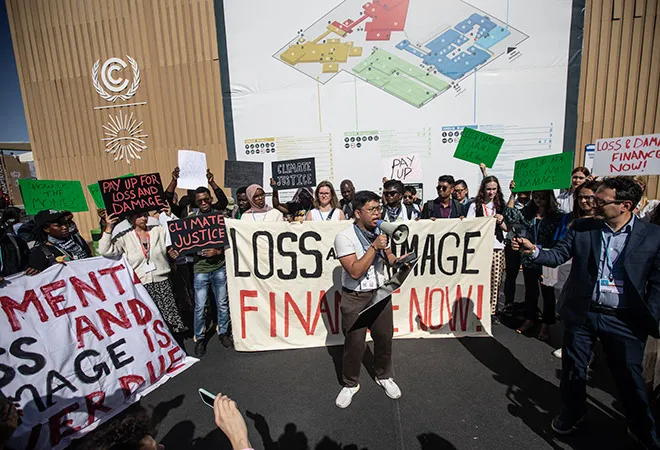-
CENTRES
Progammes & Centres
Location
Despite COP27 arriving at a momentous consensus, the deferment of key issues to future COPs has stalled concrete climate action

After three decades of derailing the discussions on the loss and damage (L&D) faced by developing countries and the establishment of a funding mechanism to compensate for the same, the UN climate negotiations have reached a momentous conclusion. However, contentious questions remain in the long road ahead towards climate action.
Despite the fact that the world is facing the brunt of the rapidly escalating impacts of climate change, mitigation and adaptation actions are advancing at a slow pace. As a consequence, developing countries that may have contributed minimally to GHG emissions are experiencing severe losses and damages occurring due to climate change. These losses include destroyed homes and infrastructure, ruined croplands and livelihood, and vanishing cultural heritage which are now categorised as economic and non-economic losses. The economic costs of loss and damage in the Global South are expected to reach US$1-1.8 trillion by 2050.
Developing countries that may have contributed minimally to GHG emissions are experiencing severe losses and damages occurring due to climate change.
Due to the recent flooding in Pakistan, the country estimated total losses of approximately US$40 billion, forcing the government to appeal for financial help from global lenders. Similar trends were witnessed globally with devastating droughts and heatwaves across Kenya, Europe and Southern China, hurricanes in the United States (US) and sea level rise forcing the Pacific inhabitants to reallocate. As the risks and vulnerabilities from climate-induced disasters increase, many developing nations are advocating for a climate finance mechanism that distinctly addresses loss and damage. Climate finance has been a critical focus point of UN climate negotiations in the past, however, the issue of loss and damage finance was adopted as a formal agenda item for the first time at the 27th Conference of Parties (COP27) to the UNFCCC at Sharm El-Sheikh, Egypt. While the deliberation of L&D finance discussions under the mandate of the convention and the 2015 Paris agreement has been widely welcomed by the world, establishing a distinct finance facility for this purpose has become a bone of contention.
Though touted to be an ‘Implementation COP’ in Africa, a continent already suffering from climate change-induced loss and damage, ended on an optimistic note but with many unresolved issues. The Global South remained adamant on the establishment of a L&D fund or facility as a part of the financial mechanism of UNFCCC which is also aligned to the Paris Agreement and ensures to be institutionalised within the guidance of the convention.
The idea of mobilising L&D finance for developing countries can be traced back to 1992 when Alliance of Small Island States (AOSIS) advocated for a financial mechanism to address damages from the rise of sea level. Even though the mechanism was not established it initiated global discussions on L&D. There have been several unsuccessful efforts to mobilise finance for loss and damage in the past including the creation of Warsaw International Mechanism for Loss and Damage in 2013. The mechanism was established under COP but it was expected to be enhanced and strengthened under the CMA which made the governance structure of WIM debatable.
Climate finance has been a critical focus point of UN climate negotiations in the past, however, the issue of loss and damage finance was adopted as a formal agenda item for the first time at the 27th Conference of Parties (COP27) to the UNFCCC at Sharm El-Sheikh, Egypt.
Loss and damage was then integrated in Article 8 of the Paris Agreement not only highlighting the importance of ‘averting, minimising and addressing loss and damage as a result of climate change’ but also eliminating the contentious elements of Decision 52 where the parties agreed that L&D does not require any legal compensation or liability. During COP25 in Madrid, the Global South pushed for stronger institutional arrangements to govern WIM. This led to the establishment of the Santiago Network for L&D which eventually led to the creation of an expert group for action and support on L&D. The demand for a distinct finance facility from the biggest Global South negotiating group including small island states, 134 developing countries, the G77 and China also led to establishment of the ‘Glasgow Dialogue’ at COP 26.
The conceptualisation and realisation of L&D finance has always been an issue of concern. There is no single definition of L&D or a mechanism to systematically track the requirement of L&D finance by developing nations under UNFCCC. There also exist certain policy bottlenecks in institutionalising L&D finance. For example, at national level, reporting information regarding loss and damage is not a mandatory part of the NDCs. Furthermore, National Adaptation Plans which are responsible for adaptation planning at the national level also does not account for loss and damage.
The 27th Conference of Parties (COP27) was expected to provide solutions to all these issues including but not limited to establishing a funding mechanism for loss and damage through Glasgow Dialogue and finalising governance arrangements for WIM. While the developed and developing nations have always locked horns on the matter of finance, this year the situation was no different. Developed countries continued to emphasise the role of financial arrangements outside of the UNFCCC as a part of a “mosaic of solutions”, further delaying talks about creating a financial mechanism under the UNFCCC as stressed by the developing countries.
The demand for a distinct finance facility from the biggest Global South negotiating group including small island states, 134 developing countries, the G77 and China also led to establishment of the ‘Glasgow Dialogue’ at COP 26.
The majority of Global South, including G77 and China, LDCs and AOSIS stressed the governance of WIM should be continued under COP while Global North including the US, the EU, Canada, Japan, and the UK argued that Article 8 clearly mandates WIM to be under the sole governance of CMA. In this regard, the COP presidency deferred the decision on the governance of WIM to future COPs, further delaying action on the matter.
The G7 and V20 also launched the Global Shield which was widely criticised as being a watered-down solution based on insurance. While all the developing nations are unanimously demanding a finance facility, investing efforts in an intervention that neither covers all developing vulnerable countries nor a range of climate impacts seemed like a mere distraction rather than a sustainable solution. Relying on insurance as a solution to minimise loss and damages can turn out to be catastrophic as it allows Global North to further profit for vulnerable and poorest communities.
As the rapidly rising impacts and costs of loss and damage become apparent, the US$100-billion goal set for 2020 was deemed insufficient to meet the escalating adaptation and mitigation requirements. As a result, the Global South insisted upon the inclusion of a third pillar to address loss and damage in the New Collective Quantified Goal (NCQG) on climate finance. This would align the commitments on L&D finance to the equity principles and common but differentiated responsibilities of all countries (CBDR) under UNFCCC. These efforts were vehemently opposed by Global North, leading to no conclusive decisions on expanding the mandate of NCQG beyond mitigation and adaptation.
In a truly momentous event, COP27 concluded with a nod for establishing a Loss and Damage Fund to assist developing countries in responding to and addressing L&D. This might be a stepping stone in the right direction which was possible because of continued deliberation and perseverance of developing countries amidst a strong pushback from the West. A 24-member Transitional Committee with majority of the members from developing countries was also created which will work on the operational modalities of the finance facility. The committee will be jointly governed by the COP and CMA. In addition, mechanisms to operationalise the Santiago Network were also agreed upon, fulfilling the key ask of G77 and China. Furthermore, many developed nations have made one-time finance pledges for loss and damage. Germany has pledged US$175 million, Belgium committed US$2.5 million, Austria and Scotland have pledged US$50 million and US$5 million respectively, and New Zealand has agreed to US$12 million. However, most of these pledges are towards Global Shield and not any distinct L&D facility.
A 24-member Transitional Committee with majority of the members from developing countries was also created which will work on the operational modalities of the finance facility.
While establishing L&D fund has been a landmark decision and has further created a pathway to engage on L&D, we must ensure that these baby steps allow us to reach greater rungs of climate action. Contentious questions still remain regarding the accessibility and accountability of the fund. Countries need to work together to make the new fund fully operational which will require efforts from both inside and outside of the convention.
The outcome of this year’s COP has been a mixed bag with partial successes and a few missed opportunities. The cost of delayed action has been high and there is still a need to scale up finance to meet both adaptation as well as L&D needs. In the backdrop of war, energy insecurity and economic impacts of pandemic, the direful track record of developed countries in delivering climate finance has caused distrust amongst the vulnerable and marginalised communities. To restore trust, it will be essential for the rich countries to take accountability, ensure equity and make significant progress within the UNFCCC. There is also an urgent need to operationalise the Santiago Network and WIM guidelines under which the fund will be materialised. The big jigsaw of climate action is incomplete without three intricate puzzle pieces of mitigation, adaptation and L&D which should move in tandem. The newly established fund is a revolutionary but small step ahead in climbing the ladder of climate justice and net-zero transition.
The views expressed above belong to the author(s). ORF research and analyses now available on Telegram! Click here to access our curated content — blogs, longforms and interviews.

Gopalika Arora is Deputy Director at the Centre for Economy and Growth, Observer Research Foundation. She leads the Centre’s work on climate and energy, focusing on ...
Read More +